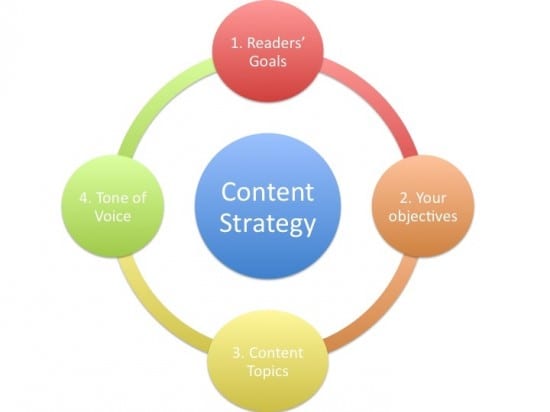Defining the four pillars of successful content
Many digital marketers are talking about 2013 being the year when Content Marketing becomes a priority. There’s been a lot of focus on tactical elements of content marketing, so in this blog post I will take a look at what I see as the foundations of a sound content strategy.
A comprehensive content strategy project would also involve outlining a plan for content process, such as workflow and maintenance, but in this post we’re going to focus on the foundations of good content. To simplify content marketing to a manageable area you can work on, I see four main areas of a content marketing strategy that need to defined to create content useful for your audience and to give a return on investment to a business.

1. Customers’ goals
Questions to ask include:
- Who are you aiming your content at?
- What are their needs, goals and objectives?
- How do they currently discover the content that’s important to them?
- Where do they consume content?
- What content do they respond best to?
It’s about understanding your audience and customers. Use any existing research you have on your customers, as well as information gleaned from focus groups, usability studies, surveys, A/B and multivariate tests, site analytics and SEO keyword analysis.
2. Your objectives
The questions here are:
- Why does your site/social media channel/mobile app/etc, exist?
- Who are the main stakeholders for these content channels in your business?
- What is the main purpose of each of these channels from your stakeholders’ perspectives?
- What key messages do you want to convey?
- How do your key messages map to your business objectives?
Like any other aspect of marketing and communication, it can be a costly mistake to dive into a content publishing project without first clarifying what you hope to achieve.
The ‘purpose’ of your content may include a number of different objectives, from ‘increase brand awareness’ to ‘persuade people to buy’. These should align with your business goals.
The type of content, messaging, as well as frequency, timing and publishing channel, will depend on where your target audience goes to find information, and what stage they are at in the buying cycle.
3. Content topics
- What are the main topic areas that you’ll publish on?
- What will you talk about?
- What subjects will you cover?
It’s important to be clear on what topics and subject matter you’ll be covering. This will help you to think about where you will source content, what kind of content you will commission (whether internally or externally), what information you will share on social networks, and so on. It’s about understanding what your audience is interested in and knowing what will provide value to them and the business. The Smart Insights content matrix will help you define the most relevant types and formats of content for your audience and your business.
4. Tone of voice
- How will you say what you’re saying?
- What style will you adopt?
- How will you maintain a consistent style across all your marketing communications?
The personality of your brand or organisation needs to be clearly communicated through all content. It’s essential to be consistent with your tone of voice if you want to create trust and engagement through quality content.
Summary
With a good content marketing strategy you can create opportunities to attract, engage and retain new customers. The framework offered here provides a checklist for thinking about how you approach your content marketing strategy. I’d love to hear your thoughts on the subject.

Thanks to
Tim Tucker for sharing his advice and opinions in this post. Tim Tucker is Director and Founder of
23 Digital Ltd You can follow him on
Twitter or connect on
LinkedIn.




 Thanks to
Thanks to 


